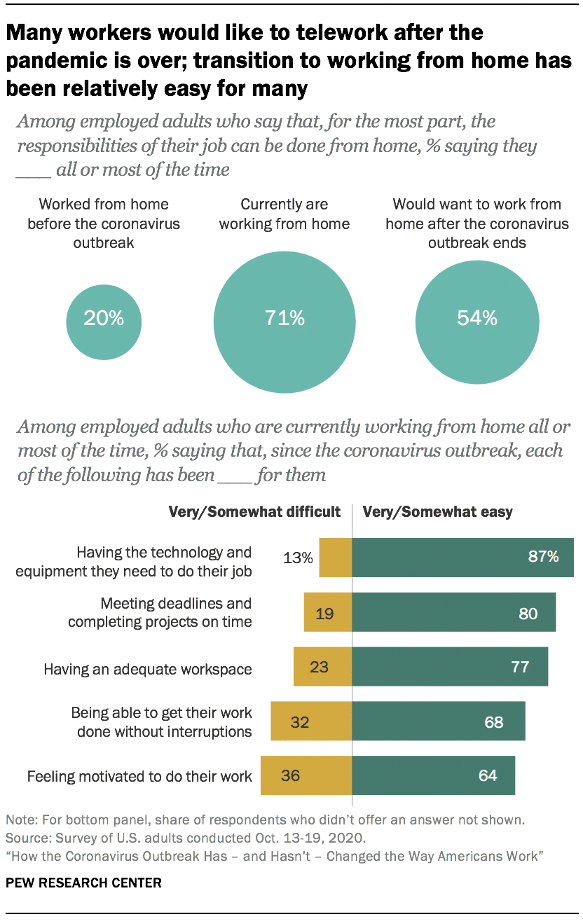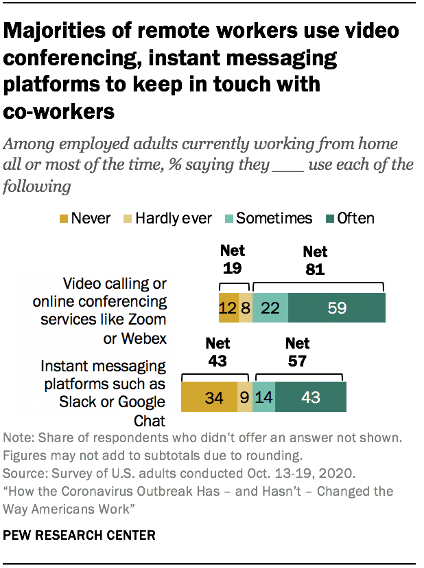You survived the crux of the pandemic crisis. HR leaders, you deserve to take a bow for your excellent leadership of safe COVID-19 policies, compliance with new laws, and your quick pivot to remote work. Hopefully, you have caught your breath; because now is the time to lead your organizations again, to optimize remote work, convert to a hybrid workforce with the necessary digital technology (and team norms to make it work), and to create a new role for the office.
The experiences of our customers and the research are overwhelming. Remote work turned out better than expected, and half of the office workforce does not want to go back to the old normal.
Back in May 2020, Global Workforce Analytics and Design Public Group published research that showed that 70% of office workers and their managers reported that they were more productive or as productive as before the pandemic. Half of these workers want to continue to work remotely two to five days a week, with two in-office days being the sweet spot.
The Pew Research Center published survey results in December 2020 with a nationally representative sample of over 10,000 workers that revealed similar findings. Workers had the technology to do their jobs, were meeting deadlines, had adequate workspaces, completed their work without interruptions, and were motivated to do their jobs (see chart right). As with the Global Workforce Analytics report, the Pew Research Report shows that slightly over half of remote workers want to continue to work from home after the pandemic.
Remote work has not worked out for everyone, according to both reports. Parents and a higher percentage of younger women have had more difficulties with remote work, due to the primary responsibility of caring for toddlers and helping older children with distance learning. Younger workers report less motivation to do work when working from home. People of color and lower-income workers have also had fewer opportunities for remote work and for those who have remote work opportunities report difficulties with the suitability of their home environment.
Contrary to what some pundits would have you believe, the Pew Research report shows that remote workers use video conferencing, instant messaging, and chatbot platforms to keep in touch with their managers and coworkers. They also note that these tools work for them. Two-thirds report that they are not fatigued by ZOOM conference calls (please the chart below).
You are facing this post-pandemic reality. Half or more of your remote workers will want to continue to work from home post pandemic. Some will want to return to the office because their home environment is not suitable for work, or they miss the in-person socialization with co-workers, or they are better motivated at the office. Of course, some workers will need to continue to come to the office because the need to work in research and development labs, access data not available online, or interact with customers. All of this creates the reality of having employees on the same teams that are in-office workers and remote workers: the hybrid workforce.
Some pundits are writing that having co-workers on the same team working from home and others in the office is a recipe for disaster. Others maintain that innovation suffers if innovation project teams are not working shoulder to shoulder 24/7. All false.
There are HR practitioners who implemented hybrid workforces with success long before the pandemic.
One example from 2012 reports that productivity soared by 22 percent for their home-based workers and their employees reported improved work-life balance. Their ability to recruit and retain employees increased. They also saved tons of carbon emissions from reduced commutes to the office and millions of dollars from moving out of no longer needed office space. One critical learning was to get remote workers in the office one or two days a week to build relationships and align all employees to the organization’s culture, strategies, and goals. Other learnings include the heavy use of digital technology and the importance of creating new norms for communications, collaborating, sharing information, and decision making for each team.
Research backs up the successful hybrid experience of HR practitioners. Global Workforce Analytics published its latest report, The Business Case for Remote Work, 2021. They conclude that if 45 percent of the workforce worked remotely for half the workweek, US employers and employees and the environment would achieve the following benefits:
Employers could collectively save over $500B a year—roughly equal to the GDP of Sweden, Belgium, or Poland—or almost $11k for each employee who works at home half the time.
Employees could collectively save over $149B a year or $3k per person and save the equivalent of over 670M days a year (14 days per person) they otherwise would have wasted time in traffic.
The environment would be spared the greenhouse gas equivalent of taking the entire New York workforce off the road for a year, and over 80K traffic accidents, injuries, or deaths would be prevented.
Finally, research published in 2020 shows that innovation and product development are improved and accelerated when project team members use a combination of time together and time working remotely at home: Together to collaborate and brainstorm; and remotely to think, get perspective, analyze data, and write up reports. These finds have also been uncovered by other researchers such as Cushman and Wakefield.
Redefining the office. In their recently published report, Cushman and Wakefield predict that the design of the office will change for many companies. When the pandemic abates, based on their modeling, with 50 percent of office workers working from home two to three days a week, the design of the office will change. Remote workers will do their heads down work at home, with fewer interruptions than in the office. They will go into the office to align, collaborate, give and receive recognition and awards, and to socialize.
The office will become more of a place for holding key meetings, sharing information and insights, innovating, mentoring, training, and connecting to the corporation’s culture and mission. Post-pandemic, the office will house some workers five days a week like before the pandemic, particularly those working in research and development labs, servicing customers, and those who prefer an office environment to their home environment. To accommodate the hybrid workforce, however, the office will also need to provide touchdown spaces for remote office workers when they are in the office, with vastly more on-demand small and large meeting rooms and videoconferencing rooms. The office will also need to allow assembly areas, casual meeting areas, and training rooms.
How should HR executives prepare to lead their organizations to this brave new world? Below is a series of recommendations:
Be aware of the research and trends and articulate the burning platform for change and the vision that clearly shows the benefits to the company and its employees.
Build key coalitions with other executives, and especially with the IT, Finance, and facility management organizations.
Articulate the how to get there that includes investment in digital technology, such as intelligent assistants, office design changes, training, and technology and the savings from these investments from reduced real estate costs.
Think about it as an organizational change and map out the necessary steps such as a Kotter Eight Step Change Model.
Articulate benefit to the business from improved productivity and innovation and reduced office costs and the benefits to employees from saved time, less interrupted work, better work-life balance, and reduced carbon emissions.
While 2020 was a challenging year for HR leaders, 2021 will continue at the same pace because the future world of work is here now.
As you work through your investment in digital technology contact us about how MeBeBot’s Intelligent Assistant has enabled success with remote work and the hybrid workforce for fast growing high-tech companies.
MeBeBot's AI-powered Intelligent Assistant breaks through where others have not in these essential areas.
It is affordable, easy to implement and update. It installs in two to six weeks, (not two to six months), providing companies with a fast time-to-value and investment return. Whether employees are in the office or working from home, it answers the commonly asked questions of HR, IT, and operations, freeing up these organizations’ staff to pursue more strategic work. It improves employees' productivity and experiences by providing accurate answers to them 24/7–no waiting for the staff or call centers to return a call.
Learn more about our customers' success stories, request a quick demonstration, and get an estimate on the incredible return MeBeBot will provide you for your investment as you transition to the hybrid workforce and the future office.



